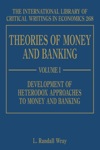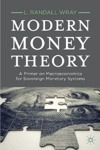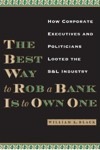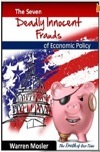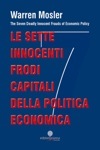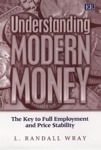(cross-posted with Benzinga.com)
The SEC and the CFTC’s budgets are not provided by the federal budget. The agencies, as with the federal banking regulatory agencies, are funded by user fees. None of these agencies’ budgets contribute to the deficit. When these agencies fail to stop epidemics of “control fraud” the result can be a Great Recession and trillions of dollars in increased deficits. The asymmetry is so stark that anyone serious about deficits would make ensuring the effectiveness of the SEC, CFTC, and the banking regulatory agencies among their greatest priorities. Supposed deficit hawks in the House are also among the strongest proponents of cutting the SEC, CFTC, and banking regulatory agencies’ budget even though this cannot have any positive effect on deficits and is exceptionally likely to produce the next financial and economic crisis that will produce the next sharp increase in the federal deficit. This is significantly insane, and it is even more insane that no one seems to call them on their insanity.
The purported logic for slashing the SEC and CFTC budgets represents another form of insanity. The logic is that the SEC and the CFTC failed to prevent the epidemic of accounting control fraud that drove the current financial crisis, the Great Recession, and the growing budget deficit. That is true, but proves the opposite. The SEC and the CFTC failures were self-fulfilling prophecies by kindred ideologues of those now seeking to slash the SEC and CFTC budgets.
Deregulation was part of the story. The Commodities Futures Modernization Act of 2000 deliberately created two regulatory black holes. The Act’s primary goal was to block Brooksley Born’s efforts to protect the public from the risks of credit default swaps (CDS), but the subsidiary goal was Enron and its fellow cartel members’ desire to manipulate energy derivatives in order to produce the California energy crisis and reap monopoly rents. I have written previously about the SEC farce of supposed “comprehensive” regulation of the largest U.S. investment banking firms (designed explicitly to exempt them from comprehensive regulation by the European Union).
The larger part of the story, however, was desupervision and de facto decriminalization. My prior columns have detailed how our anti-regulatory leaders were selected precisely because they opposed vigorous enforcement of the nation’s securities and banking laws.
Collectively, the three “des” – deregulation, desupervision, and de facto decriminalization – created a crippling “systems capacity” crisis that achieved its goal of eliminating effective financial regulation in the U.S. for roughly a decade. The result of removing the regulatory system’s capacity to deal effectively with accounting control fraud was an epidemic of such fraud that caused the worst financial and economic crisis in 75 years. There is something outright obscene for the ideologues that gutted regulatory effectiveness to claim that their “success” in causing the regulatory failures justifies exacerbating those failures by budgetary cuts.
Deliberate, crippling limitations on financial regulatory budgets, staffing levels, and pay have played important roles in causing systems capacity problems in prior crises. Consider six recent financial regulatory staffing crises and the House’s ongoing attempts to worsen the SEC and the CFTC’s systems capacity problems.
1. In the savings & loan debacle, the Reagan administration froze the hiring of examiners and OMB refused to allow the agency the authority to hire any material increase in staff. Congress limited the Federal Home Loan Bank Board’s pay authority to levels materially less than its sister regulatory agencies. This mandatory pay disparity caused the Bank Board to suffer from excessive turnover, staff shortages, and inadequate staff quality. Bank Board Chairman Gray’s innovative use of the Federal Home Loan Banks to hire staff at competitive pay levels and his personal recruitment of senior banking regulators with a track record of vigorous regulation proved essential to the successful reregulation and supervision of the industry that contained that debacle before it could cause an economic crisis.
2. In the run up to the Enron era crisis, Congress limited the SEC’s pay grades to levels materially below the banking regulatory agencies. This produced the same pattern of high turnover, staff shortages, and impaired quality. Republicans in Congress repeatedly sought to exacerbate the SEC’s systems capacity crisis by reducing its budget – at a time when its regulatory duties were growing massively because of the extraordinary growth of finance.
3. In the run up to the current crisis the FDIC’s leadership, over the course of 15 years, cut the FDIC staff by more than three-quarters. The FDIC often used “early outs” to shed its most expensive staff, i.e., its most experienced staff. The combined effect was that the FDIC’s remaining staff was so grossly inadequate that it could not examine the banks. It responded to its systems incapacity by greatly reducing its non-safety and soundness examinations (particularly examinations of compliance under the Community Reinvestment Act (CRA)), by virtually ending the use of its “backup” examination authority of banks for which the FDIC was not the primary regulator, and by adopting the infamous MERIT examination system for safety and soundness examinations. MERIT was a travesty. It achieved its purported “maximum efficiency” by directing examiners not even to review a sample of bad loans. Again, this was insane – failing to examine loan quality makes examination a farce. The FDIC gutted its staff even as the need for examination and supervision grew dramatically due to the profusion of fraudulent liar’s loans and the hyper-concentration of smaller banks in commercial real estate lending.
4. The Office of Thrift Supervision (OTS) also cut its staff in the run up to the current crisis. It did so even though S&Ls were the leading federally insured lenders making fraudulent liar’s loans and the need for intense examination and supervision required greatly increased staff.
5. The SEC and the CFTC suffered from severe budgetary and staffing limitations in the run up to the current crisis. Congress initially expanded the SEC’s budget and staff in response to the Enron-era crisis, but the number of SEC staff fell materially during the key years in the run up to the financial crisis. For the SEC and the CFTC, this decreased staffing was particularly harmful because the agencies faced a substantial need to provide staff to investigate the Enron-era frauds and greatly increased market manipulation at the same time that the epidemics of accounting control fraud and the underlying mortgage fraud were surging. The SEC and the CFTC also faced the overall rapid expansion of finance and technological changes in derivatives and hyper-trading. These changes caused critical inadequacies in SEC and CFTC staff levels, staff expertise, and technological resources.
6. Contemporaneously, the FBI and the Department of Justice suffered from critical staffing inadequacies to deal with the twin, related epidemics of accounting control fraud and mortgage fraud. The FBI transferred 500 FBI agents specializing in white-collar crime investigations to national security in response to the 9/11 attacks. The administration refused to allow the FBI to replace these lost white-collar specialists. The loss of the white-collar FBI agents was made far worse by the need to assign hundreds of the remaining FBI white-collar crime specialists to investigate the Enron-era accounting control frauds. The combined effect was that as late as FY 2008 there were only 180 FBI agents assigned to investigate mortgage fraud. There were 1000 FBI agents assigned to investigate S&L frauds during the debacle. Those FBI agents, working closely with the regulators, were essential to producing the over 1000 felony convictions in “major” S&L frauds committed during the debacle. The current crisis, of course, is vastly greater than the S&L debacle but we have roughly one-fifth as many FBI agents assigned to investigating the current frauds (and they are overwhelmingly assigned to relatively minor cases).
Not a single senior executive at the large fraudulent lenders making the liar’s loans has been convicted. Our most elite accounting control frauds now loot with impunity. The deliberate creation of severe systems capacity problems is an important contributor to the death of accountability and the rise of crony capitalism in the United States.
In my next column I will draw on the warnings of Lynn Turner, the SEC’s former chief accountant, about the increasing systems capacity problems at the SEC and the CFTC and the role of proposed budget cutbacks in creating the criminogenic environment that will help produce the next financial crisis. Again, none of these insane policies reduce governmental debt, but they do cause the recurrent, intensifying financial crises. Those crises caused hundreds of billions of dollars of losses in prior crises and now cause trillions of dollars of losses and deficits.


